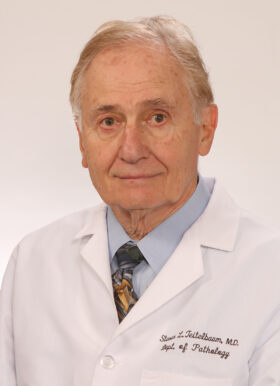
Steven Teitelbaum, MD
Wilma and Roswell Messing Professor of Medicine, Pathology and Immunology
- Phone: 314-454-8463
- Fax: 314-454-5505
- Email: teitelbs@nospam.wustl.edu
Dr. Steven Teitelbaum graduated from Washington University School of Medicine and completed his clinical training at this institution and NYU. He holds the Messing Chair in Pathology and Immunology and is Professor of Medicine in the Division of Bone and Mineral Diseases. He has published in excess of 300 papers, many in the most competitive journals. Dr. Teitelbaum’s laboratory focuses on the mechanisms of osteoclast bone resorption and has recently extended his interests to the interactions between bone, fat, and energy metabolism. He is a world-leading bone biologist and mentor, having trained more than 70 undergraduate, graduate students, and postdoctoral fellows, a number of whom now hold prestigious positions and enjoy international reputations as skeletal biologists.
Editorial Responsibilities
- Advisory Editorial Board: Journal of Experimental Medicine
- Editorial Board: Cell Metabolism
DBBS Graduate Program Affiliation
- Molecular Cell Biology
Professional Societies and Organizations
- American Society for Clinical Investigation
- Association of American Physicians
- American Society for Bone and Mineral Research
- International Bone and Mineral Society
- American Society for Investigative Pathology
Recognition
- President, American Society for Bone and Mineral Research, 1992-93
- American Society for Bone and Mineral Research, William F. Newman Award, given for outstanding and major scientific contributions in the area of bone and mineral research and for contributions to associates and trainees in teaching, research and administration, 1998
- President, FASEB, 2002 – 2003
- Boy Frame Award for Clinical Excellence in the Field of Bone and Mineral Metabolism, American Society for Bone and Mineral Research, 2003
- Rous-Whipple Award, American Society for Investigative Pathology, 2006
- MERIT Award, National Institute of Arthritis and Musculoskeletal and Skin Diseases, 2010
Clinical Interests
- Metabolic Diseases of Bone
- Osteoporosis
- Renal Osteodystrophy
Research Interests
Our laboratory focuses on the mechanisms by which osteoclasts resorb bone. Our general strategy is to establish that deletion of a molecule of interest, in vivo, produces a robust skeletal phenotype. If we find such is the case, we employ molecular and cellular techniques to determine the mechanisms by which the targeted molecule regulates the osteoclast and potential clinical relevance. We have established that organization of the osteoclast’s unique cytoskeleton, which is central to its capacity to resorb bone, is mediated by an αvβ3 integrin-activated signaling complex involving c-Src, Syk, Dap12, Slp76, Vav3 and Rac. We have proven the physiological relevance of each of these signaling molecules as their deletion results in osteoclast dysfunction and osteopetrosis, in vivo. Deletion of these molecules is also protective of pathological bone loss and thus, they are candidate therapeutic targets. We have established that the osteoclastogenic cytokines, M-CSF and RANK ligand, regulate the osteoclast cytoskeleton by stimulating the same signals as the αvβ3 integrin. In the case of M-CSF, its collaboration with the integrin represents inside-out conformational stimulation mediated by talin. RANK ligand, on the other hand, requires αvβ3 for its cytoskeletal effects, but by different mechanisms which are presently under investigation. Finally, we have established that the osteoclast exerts its bone resorptive effects by functioning as a secretory cell wherein lysosomal vesicles containing skeleton-degrading molecules polarize and insert into the bone-apposed plasma membrane under the influence of Synaptotagmin VII and autophagy proteins. The polarized resorptive machinery thereby creates an isolated extracellular microenvironment in which bone is degraded.
Publications
- Kitaura, H., Zhou, P., Novack, D.V., Ross, F.P., Teitelbaum, S.L. M-CSF mediates TNF-induced inflammatory osteolysis. J Clin Invest 115:3418-3427, 2005.
- Kim, H.J., Zhao, H., Kitaura, H., Bhattacharyya, S., Brewer, J.A., Muglia, L.J., Ross, F.P., Teitelbaum, S.L. Glucocorticoids suppress bone formation via the osteoclast. J Clin Invest 116:2152-60, 2006.
- Zou, W., Kitaura, H., Reeve, J., Tybulewicz, V.L.J., Shattil, S.J., Ginsberg, M.H., Ross, F.P., Teitelbaum, S.L. Syk, c-Src and the v3 integrin, in concert, regulate osteoclastic bone resorption. J Cell Biol 176:877-888, 2007.
- Zhao, H., Chappel, J., Ito, Y., Andrews, N.W., Teitelbaum, S.L., Ross, F.P. Synaptotagmin VII regulates bone remodeling by modulating osteoclast and osteoblast secretion. Dev Cell 14:914-925, 2008.
- Zou, W., Zhu, T., Craft, S.S., Broekelmann, T.J., Mecham, R.P., Teitelbaum, S.L. Cytoskeletal dysfunction dominates in Dap12-deficient osteoclasts. J Cell Sci 123:2955-2963, 2010.